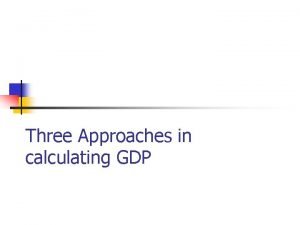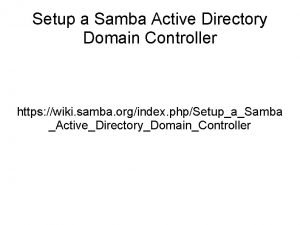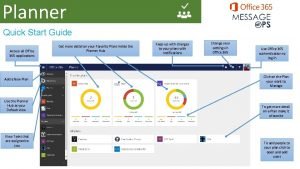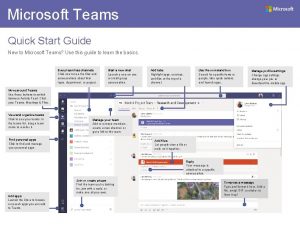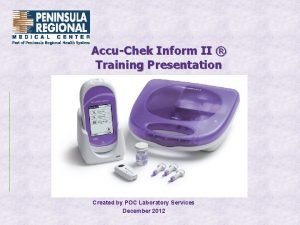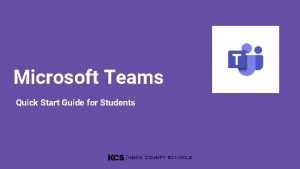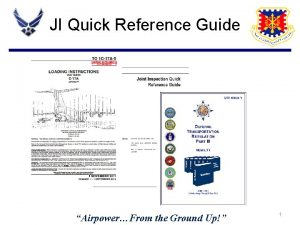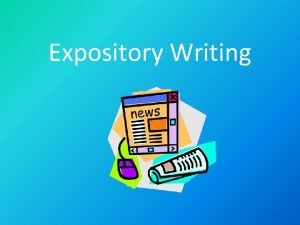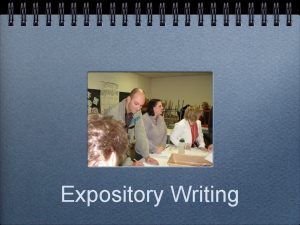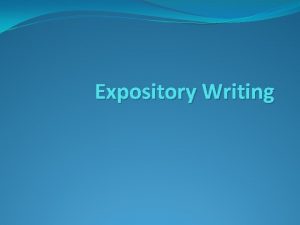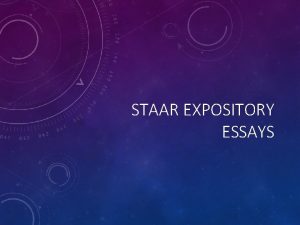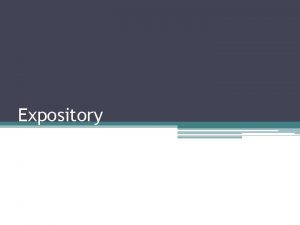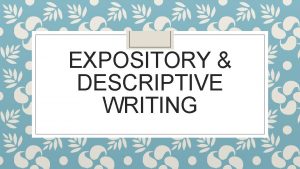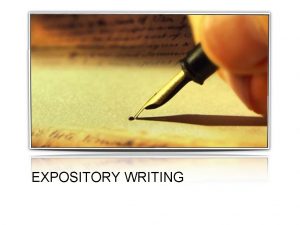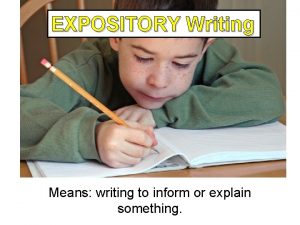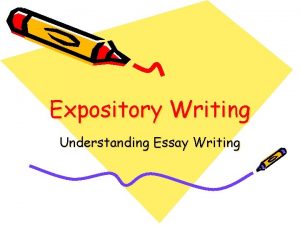EXPOSITORY WRITING A quick howto guide WHAT IS











- Slides: 11

EXPOSITORY WRITING A quick how-to guide

WHAT IS AN EXPOSITORY ESSAY? • An expository essay is an essay that shows NO bias: It is informative in nature. • It can compare/contrast, analyze cause/effect, explain how to do something, or explain what something is or means. • It is a formal piece of writing; therefore, using first and second person pronouns is not allowed. The ONLY time these pronouns are acceptable is when they are in a direct quote. • These pronouns include the following: I, me, my, mine, yours, us, we, our • Any place you would use you, replace it with one

WHAT DO I NEED IN MY ESSAY? Your essay needs to have: • An introduction that contains a clear, concise thesis statement. • Clear and logical transitions must be used between your introduction, body paragraphs, and conclusion AS WELL AS within your body paragraphs to show a shift between evidence and explanation • Each body paragraph must contain evidence AND an explanation of the evidence • The evidence is to show that you aren’t making things up • The explanation of evidence shows how your chosen quote helps support what you are trying to inform the audience about • A conclusion that reviews/summarizes what all of your body paragraphs discussed and leaves an impact on the audience

THE INTRODUCTION • You must always start with a hook of some sort to get the audience’ attention. This can be a quote, a question, an interesting fact, or a strong statement. • After your hook, you must provide some background information regarding your chosen topic. Assume your audience knows nothing about your topic, what is the most basic information they would need to know in order to follow what you will discuss? What you discuss in your background information will NOT be discussed in your body paragraphs. • The last sentence of your intro. should be your thesis statement. Your thesis needs to be ONE sentence in length, be clear, be parallel, and be to the point.

THE THESIS STATEMENT • Your thesis statement is a one sentence summary of your entire paper. • Your thesis statement is the anchor of your essay. All of your topic sentences and evidence all connect back to thesis. Your reasons/ideas in your thesis must be listed in the order you will discuss them in your paper. • It follows the following formula : • Topic + Focus on topic/Claim + Ideas regarding the focus • Your thesis must be specific. This means that there is no question what you will discuss within your paper: Everything is clearly stated in thesis. • Pretend that your thesis IS your essay; you would want it to be super clear and specific in order to get a good grade as well as have people know what you’re saying, right?

THE BODY PARAGRAPHS • You start each body paragraph with a topic sentence. This informs the reader what idea the paragraph will focus on. If it’s not in the topic sentence, it shouldn’t be in your paragraph and vise versa. Your topic sentences must be clear and to the point. Your topic sentence focuses on one of the points you stated in your thesis. • Your body paragraphs must have evidence to support your paragraph’s idea. Your evidence must be a direct quote (this helps you to avoid accidental plagiarism) and have an in-text citation (this helps prevent plagiarism). All of your evidence must connect back to your thesis statement/topic sentence of the paragraph.

BODY PARAGRAPHS CONTINUED • After you include your evidence, you must be sure you explain the evidence’ significance to your paper WITHOUT saying “this is important to my essay because…” or “this proves my point about _____ because…” or anything of the like. • You can have more than one piece of evidence in each body paragraph, but you must explain its significance BEFORE you move on for each piece. • The final sentence in each body paragraph is the clincher sentence. This lets you summarize your paragraph’s point and helps you transition into the next paragraph’s idea. Overall, the clincher helps your essay flow.

THE CONCLUSION • Your conclusion is the reverse of your introduction. • You begin with a reworded thesis statement. This reminds the reader what your essay’s purpose was. • After you reword your thesis, you write a summary of your essay’s points discussed within your body paragraphs. This reminds the reader what you discussed as well as help them understand a concept if they didn’t get it the first time they read it. • You NEVER introduce new information within your conclusion paragraph…EVER. • After your summary, you end with a final thought. This is your final chance to “wow” the reader. It is to be treated similarly as the hook; meaning, you can use a question, interesting fact, strong statement, or a quote.

HOW DO I ORGANIZE MY ESSAY? • Your essay must always start with the introduction and end with the conclusion. The trouble comes to ordering the body paragraphs. • You need to “rank” your body paragraphs. • Pretend that each body paragraph is an ambassador for your essay. • Which one is too shy and needs another to help it along? This paragraph would be the one to start your body paragraphs. • Which ambassador is very confident and can stand alone? This paragraph, then, would be the last body paragraph (the one right before your conclusion). • The remaining paragraphs would be in the middle of these two and ranked from worst to best (most shy to most confident) and ordered as such. • You do this so that you end on a strong, lasting note with your audience. This is very similar to when you are trying to convince your parents to let you do something: You use your BEST stuff last.

HOW DO I KNOW IF I HAVE A RELIABLE SOURCE? Who is the author? –Reliable/credible sources are written by authors respected in their fields of study. Responsible/credible authors will cite their sources so you can check the accuracy of and support for what they’re written (this also lets you springboard to other sources for your own research!) How recent is the source? —The choice to seek recent sources depends on your topic. History may not need recent sources. Sources discussing technology/medicine need to be more current as they are ever-changing

BE CAREFUL WHEN EVALUATING INTERNET SOURCES!! NEVER use websites where an author cannot be determined, unless the site is associated with a reputable institution such as a respected university, a credible media outlet, government program or department, or well-known non-government organizations. Beware sites like Wikipedia, which are collaboratively developed by users. Because anyone can add or change content, the validity of information on such sites may not meet the standards for academic research. Ebsco Host and Google Scholar are databases that house nothing but reliable sources so you don’t have to worry about if you can use a source or not.
 Calculate gross domestic product
Calculate gross domestic product Samba domain controller einrichten
Samba domain controller einrichten Quick find vs quick union
Quick find vs quick union The fan blade is speeding up. what are the signs of
The fan blade is speeding up. what are the signs of Expository writing introduction
Expository writing introduction Proteus guide
Proteus guide Planner quick start guide
Planner quick start guide Microsoft teams quick start guide
Microsoft teams quick start guide Accu-chek inform ii quick reference guide
Accu-chek inform ii quick reference guide Ms teams quick start guide
Ms teams quick start guide Joint inspection quick reference guide
Joint inspection quick reference guide Thsteps catalog
Thsteps catalog
